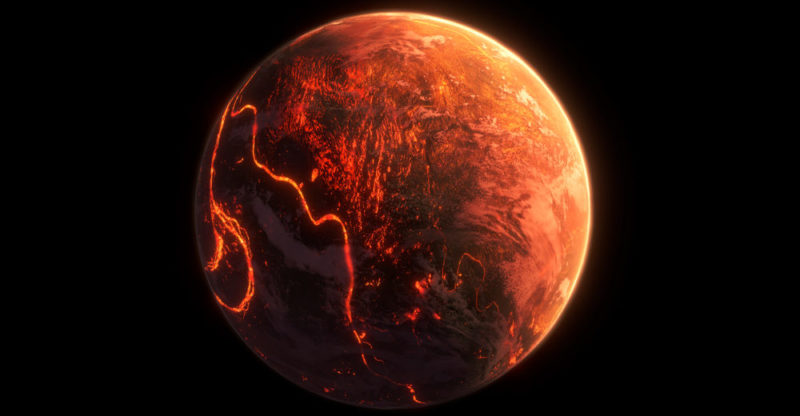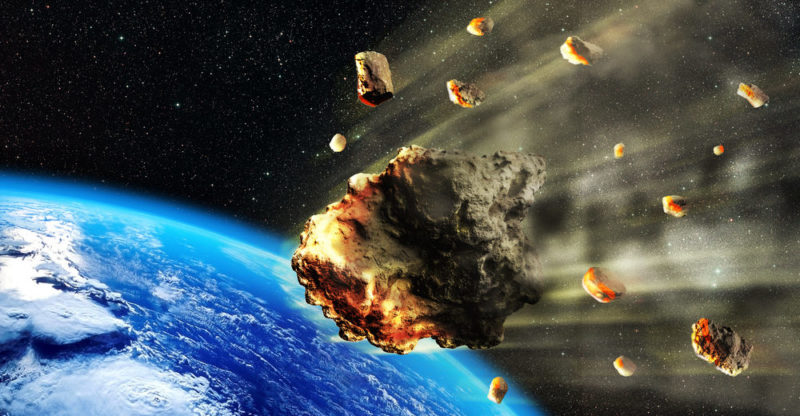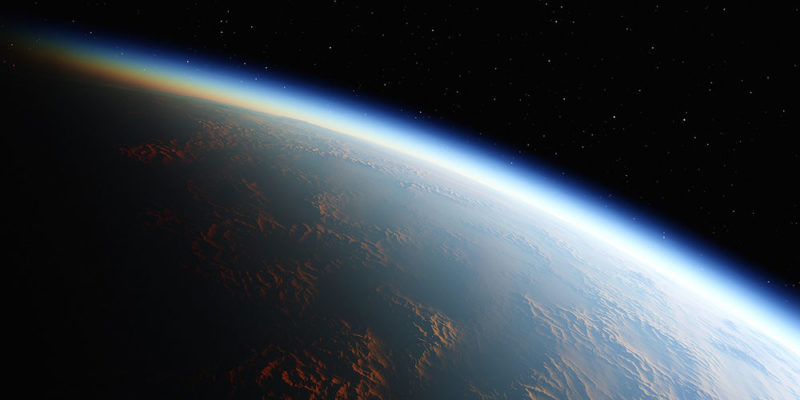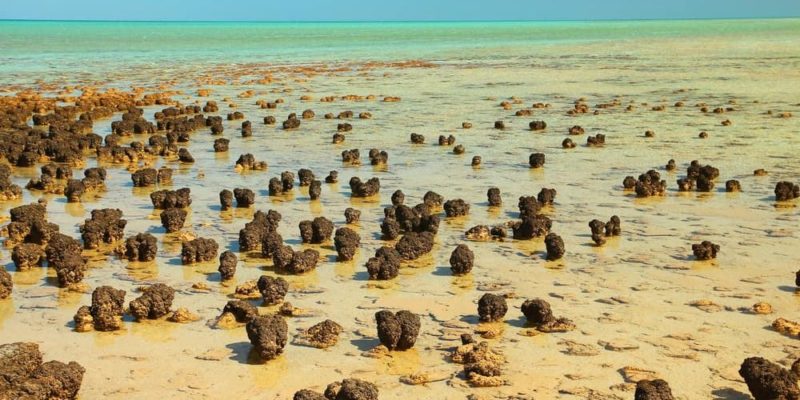We explain what the Archaic Aeon was, the stages into which it is divided, and its characteristics. Also, the first forms of life and the oceans.
What was the Archaic Aeon?
The Archaic Aeon was formerly called Archezoic, or simply Archaic (and in some places erroneously referred to as the Archaic Era). It is the second geological period of the terrestrial geological time scale that integrates the so-called Precambrian Supereon.In some classifications it is treated as the first, including in the Archaic the events of the Hadic or Azoic Aeon . This is because the difficulties of studying these ancient times do not allow us to determine with certainty when one ends and the other begins.
It is presumed that the Archaic began approximately 4,000 million years ago , once the Earth was formed, in its most primitive geological and atmospheric stages. It ended about 2.5 billion years ago, beginning the Proterozoic Aeon.
The Archaic was a significant period in the early formation of the planet, in which primitive life emerged and the first evolution of the earth's crust occurred . Its name comes from the Greek arche , "origin" or "beginning."
Previous aeon
 The Hadic or Azoic began in the most remote possible times: those of the formation of our planet itself, about 4657 million years ago .
The Hadic or Azoic began in the most remote possible times: those of the formation of our planet itself, about 4657 million years ago .Their names suggest the absence of life since it is the period of stabilization and initial cooling of the Earth.
Atmospheric and chemical conditions were incompatible with life. It is the initial eon of the Precambrian and of the geological history of the world.
Archaic Division
The Archaic eon is divided into four Eras or Eratemes, as it progresses in its geological time, without subsequent periods or subdivisions:
- It was Eoarcaica. It begins about 4,000 million years ago, after the formation of the Earth and the events of the Hadic Aeon.
- It was Paleoarchic. It begins sometime 3.6 billion years ago.
- It was Mesoarchic. It begins sometime 3.2 billion years ago.
- It was Neoarchic. It begins sometime between 2,800 and 2,500 million years ago, and upon completion, the Proterozoic Aeon begins.
Geological characteristics of the Archaic eon
 Given that this is the beginning of the evolution of the earth's crust , it can be assumed that there was some type of plate tectonics similar to that found today. However, it was at much greater speed and intensity.
Given that this is the beginning of the evolution of the earth's crust , it can be assumed that there was some type of plate tectonics similar to that found today. However, it was at much greater speed and intensity.The latter is due to the fact that the heat flux of the planet towards its crust was three times greater than the current one , which increased the movements of the lithosphere and allowed much smaller plates as well.
Thus, there were no large continents on the planet until the end of the Archaic , but protocontinents that collided constantly and on at least three occasions met to temporarily form a larger unit.
Towards the end of the period, it is possible that volcanic and tectonic activity destroyed more than one continent . Among the rocks generated during this period are the plutonic masses of granite, dorite, anorthosite, and monzonite.
Climatic characteristics of the Archaic eon
Unlike the current one, in the Archaic atmosphere there was no presence of free oxygen , but greenhouse gases such as carbon dioxide and methane, the latter forming constant mists in the air .However, there were already water deposits (and therefore water vapor in the atmosphere ) that contributed to the very gradual cooling of the planet. Also contributing was the fact that the sun was 30% dimmer than it is today .
The Late Heavy Bombardment
 This is what is known as a phenomenon that occurred on our planet between 3.8 billion years ago and approximately 4.1 billion years ago. It consisted of a set of large asteroid collisions with Earth and the Moon .
This is what is known as a phenomenon that occurred on our planet between 3.8 billion years ago and approximately 4.1 billion years ago. It consisted of a set of large asteroid collisions with Earth and the Moon .It was the cause of some of the large craters that can be seen on the latter (and even on Mercury ). These meteors would have contributed additional energy charges that increased the Earth's temperature and were partially responsible for the slow cooling of the planet.
The first forms of life
Life formally began in the Archaic aeon, sometime in its 1.5 billion year duration . There is evidence of prokaryotic organisms known as cyanobacteria. They were unicellular organisms capable of fixing chemical elements to obtain energy , coming from at least 3,500 million years ago.The first fossils of life forms are of bacterial origin (archaebacteria). These early forms of prokaryotic life, we might call blue-green algae, they performed a anoxygenic photosynthesis: not release oxygen to the environment , as do today the bacteria green of the sulfur and purple bacteria.
However, at some point in the Neoarchic, 2.8 billion years ago, photosynthesis as we know it began. Thus, free oxygen began to be released into the atmosphere.
The supercontinent of Vaalbará
 Vaalbará is a hypothetical first supercontinent that would have formed during the Paleoarchic Era 3,800 to 3,600 million years ago. It is assumed that it fragmented again sometime before 2.8 billion years ago.
Vaalbará is a hypothetical first supercontinent that would have formed during the Paleoarchic Era 3,800 to 3,600 million years ago. It is assumed that it fragmented again sometime before 2.8 billion years ago.It is believed to have formed from two archaic cratons called Kaapvaal (part of South Africa) and Pilbara (part of Australia) . This follows from the geological similarities between these two very distant regions.
The formation of the oceans
Towards the end of the Archaic eon, the great accumulations of water (which later formed the oceans ) reached more or less 50% of the surface that they currently occupy . However, their formation was continuous, as volcanic activity pushed more and more water vapor into the atmosphere, which then precipitated.The water also flowed from deep ocean basins in which there was an abundant presence of iron , which, unable to oxidize, dissolved. This element was extremely abundant and played a vital role in the appearance of life, but also gave the waters of the sea a reddish color that today would be unrecognizable to us.
Stromatolites
 Stromatolites are the first constructions of biological origin that exist on the planet . They are mineral structures, of diverse morphology, whose origin is in the capture and fixation of carbonate particles by the first and primitive forms of life.
Stromatolites are the first constructions of biological origin that exist on the planet . They are mineral structures, of diverse morphology, whose origin is in the capture and fixation of carbonate particles by the first and primitive forms of life.This means that cyanobacteria of the Archean anoxygenic photosynthesis conducting a capturing carbon from CO 2 abundant in the atmosphere. With it they formed carbonates, which accumulated and sedimented, forming small rocky constructions that remain until today.
There are fossil stromatolites from almost all geological eras , and they are the oldest evidence of life on the planet. Those from the Archaic aeon are found today in Warrawoona, Australia.
Next Aeon: the Proterozoic
The Proterozoic is the eon following the Archaic, the final part of the so-called Precambrian time . It begins about 2,500 million years ago and is the time when the Earth undergoes its first glaciations, as well as the accumulation of oxygen in the atmosphere known as the Great Oxidation or the Oxygen Crisis.There are also the first eukaryotic life forms and the first multicellular organisms (metazoans) in history.
She has pursued her studies in The United States, where she has graduated in Business and Economics and is currently finishing her Master studies in International Economics and Finance. Miss. Amputee is fluent in three languages: English, Spanish and Russian and has elementary knowledge of French and Italian. She love exploring how Collaborative Research Group can become the best tool to achieve the (necessary) educational change. .
Leave a reply
Your email address will not be published. Required fields are marked *Recent post

Sport: What Is It, Types, Risks, Features, Characteristics and Examples
September 23, 2021

Dogs: Emergence, Features, Characteristics, Feeding and Breeds
September 24, 2021

Story: Definition, Elements, Structure, Features and Characteristics
September 24, 2021

Essay: Definition, Structure, Features, Characteristics, How to Do It
September 24, 2021
